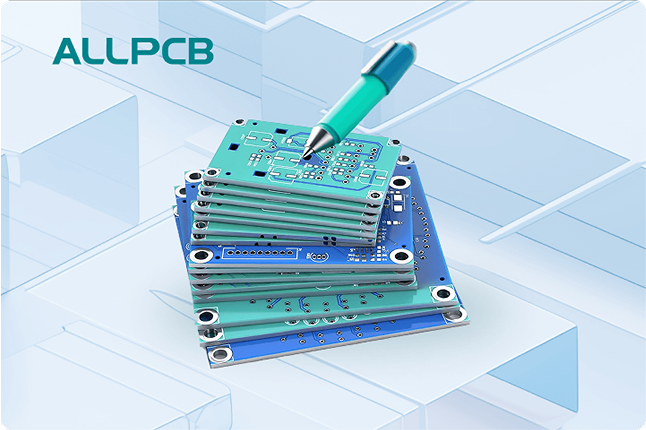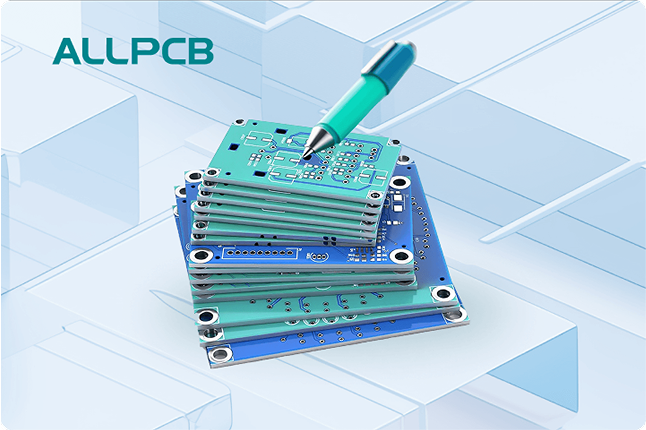Are you struggling with electromagnetic interference (EMI) in your op-amp circuits? For electrical engineers working on sensitive analog designs, a proper PCB layout can make all the difference. In this blog, we’ll dive into op amp PCB layout guidelines and EMI reduction techniques for op amps to help you achieve cleaner signals and better performance. We’ll cover critical topics like op amp ground plane design, op amp decoupling capacitor placement, and mixed-signal PCB design for op amps. Let’s get started with actionable tips to optimize your designs!
Why Op-Amp PCB Layout Matters for EMI Reduction
Operational amplifiers (op-amps) are the backbone of analog circuits, used in everything from audio amplifiers to precision sensors. However, their high gain and sensitivity make them prone to picking up EMI, which can degrade signal quality or cause erratic behavior. A poorly designed PCB layout can act like an antenna, amplifying noise from nearby digital circuits, power supplies, or external sources.
For engineers, the goal is to minimize noise coupling and ensure signal integrity. A well-thought-out PCB layout reduces parasitic effects, controls ground loops, and shields sensitive traces. In the sections below, we’ll break down specific strategies to tackle EMI in op-amp designs, helping you build reliable circuits for even the most demanding applications.
Key Principles of Op-Amp PCB Layout Guidelines
Before diving into detailed techniques, let’s cover the foundational principles of op amp PCB layout guidelines. These rules apply whether you’re working on low-frequency audio circuits or high-speed data acquisition systems.
- Minimize Loop Areas: Smaller loop areas in signal and power traces reduce the chance of EMI pickup. Keep traces short and direct.
- Separate Analog and Digital Domains: Mixing analog and digital signals without proper isolation can introduce noise. Use separate ground planes and careful routing.
- Prioritize Component Placement: Place sensitive components like op-amps and feedback resistors close together to reduce trace lengths and parasitic capacitance.
- Use Proper Grounding: A solid ground plane is critical for providing a low-impedance return path and shielding against EMI.
With these basics in mind, let’s explore specific techniques for EMI reduction.
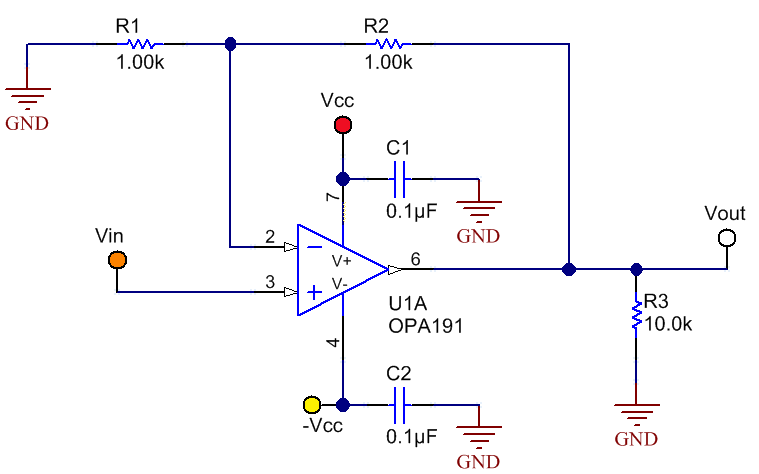
EMI Reduction Techniques for Op-Amps
EMI can sneak into your op-amp circuit through conducted or radiated paths. Here are proven EMI reduction techniques for op amps to keep noise at bay.
1. Shield Sensitive Traces
High-impedance nodes, like the inputs of an op-amp, are particularly vulnerable to EMI. To protect them, route these traces away from noisy areas such as switching power supplies or high-speed digital lines. If possible, surround sensitive traces with ground traces or a ground pour to act as a shield. For example, in a non-inverting amplifier circuit, keep the input trace to the (+) pin as short as possible and flanked by ground.
2. Use Guard Rings
For ultra-sensitive applications like precision instrumentation, consider adding a guard ring around the op-amp’s input pins. A guard ring is a conductive trace connected to a low-impedance point (often ground) that encircles high-impedance nodes. This helps absorb stray electric fields before they interfere with the signal. Ensure the guard ring is tied to the same potential as the input to avoid creating a voltage gradient.
3. Filter Power Supply Noise
Power supply noise can couple directly into an op-amp’s output. Use low-pass filters, such as an RC or LC network, on the supply lines to block high-frequency noise. For instance, a 10-ohm resistor in series with a 1 μF capacitor can form a simple filter with a cutoff frequency around 15.9 kHz, sufficient for many low-frequency op-amp circuits.
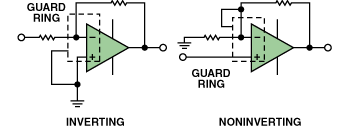
Op-Amp Ground Plane Design: Building a Solid Foundation
One of the most critical aspects of EMI reduction is op amp ground plane design. A poorly designed ground can introduce noise, create ground loops, and ruin signal integrity. Here’s how to get it right.
1. Use a Continuous Ground Plane
A solid, unbroken ground plane provides a low-impedance return path for currents, reducing the risk of EMI. Avoid splitting the ground plane unless absolutely necessary, as splits can force return currents to take longer paths, creating noise. For a 4-layer PCB, dedicate one layer entirely to ground to ensure minimal impedance—typically less than 0.1 ohms across the plane at low frequencies.
2. Implement Star Grounding for Mixed-Signal Designs
In mixed-signal PCB design for op amps, where analog and digital circuits coexist, use a star grounding technique. This means connecting all ground points to a single, central ground node to prevent digital switching noise from contaminating analog signals. For example, tie the ground pins of digital ICs and analog op-amps to separate branches that meet at a common point near the power supply return.
3. Avoid Ground Loops
Ground loops occur when return currents have multiple paths, creating voltage differences that induce noise. To prevent this, ensure all components in the analog section reference the same ground point. If you must split ground planes (e.g., for analog and digital sections), connect them at a single point to maintain a unified reference.
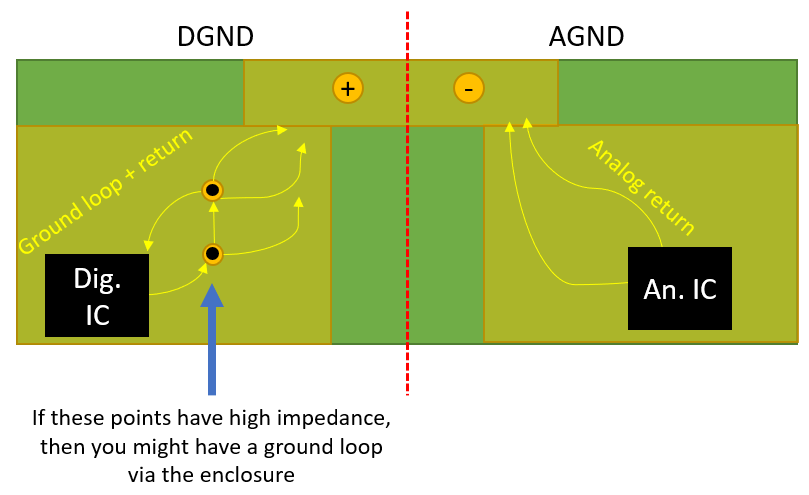
Op-Amp Decoupling Capacitor Placement: Taming Power Supply Noise
Decoupling capacitors are your first line of defense against power supply noise. Proper op amp decoupling capacitor placement ensures a stable voltage supply, especially for high-frequency or high-gain op-amps. Here’s how to do it effectively.
1. Place Capacitors Close to Power Pins
Position decoupling capacitors as close as possible to the op-amp’s power supply pins (V+ and V-). This minimizes the inductance of the traces, allowing the capacitor to respond quickly to transient current demands. Ideally, keep the distance under 0.1 inches (2.54 mm) to limit parasitic effects. Use a combination of values, such as a 0.1 μF ceramic capacitor for high-frequency noise and a 10 μF electrolytic for low-frequency ripple.
2. Use Low-ESR Capacitors for High-Speed Designs
For op-amps operating above 1 MHz, such as in RF applications, choose capacitors with low equivalent series resistance (ESR). Low-ESR ceramic capacitors (e.g., X7R or X5R types) reduce voltage drops during fast switching, ensuring stable operation. Check the capacitor’s datasheet for ESR values—aim for less than 0.05 ohms if possible.
3. Route Power Traces Efficiently
Route power traces to the op-amp before connecting to the decoupling capacitor, then to the rest of the circuit. This ensures the op-amp sees the cleanest possible supply voltage. Avoid sharing power traces with noisy components like digital logic or switching regulators.
Mixed-Signal PCB Design for Op-Amps: Balancing Analog and Digital
In modern electronics, op-amps often share a board with digital components like microcontrollers or ADCs. Mixed-signal PCB design for op amps requires careful planning to prevent digital noise from corrupting analog signals. Here are key strategies.
1. Partition Analog and Digital Sections
Physically separate analog and digital components on the PCB. Place op-amps and their associated circuitry in one area, away from digital ICs and high-speed clock lines. If using a split ground plane, ensure the analog ground is under the op-amp section and the digital ground is under the digital components, connecting them at a single point as discussed earlier.
2. Control Clock and Switching Noise
Digital clocks and switching signals generate high-frequency harmonics that can couple into op-amp inputs. Route clock traces on a different layer from analog signals, and avoid running them parallel to sensitive traces. If possible, use a slower clock rate (e.g., reduce from 50 MHz to 25 MHz) to lower EMI, provided it doesn’t impact system performance.
3. Use Differential Signaling for Analog Inputs
In noisy mixed-signal environments, consider differential op-amp configurations. Differential inputs reject common-mode noise, making them less susceptible to EMI from nearby digital circuits. For instance, in a sensor application, route the signal as a differential pair to the op-amp’s inputs, maintaining equal trace lengths to avoid phase mismatch.
Practical Tips from Real-World Experience
Over the years, I’ve worked on numerous op-amp designs, from audio preamps to industrial control systems. One lesson stands out: always prototype and test your layout. On a recent project involving a precision op-amp for a strain gauge sensor, I noticed subtle noise in the output despite following standard guidelines. After probing, I found that a nearby switching regulator was coupling noise through the ground plane. Adding a small ferrite bead in series with the op-amp’s supply line, combined with a 1 μF capacitor, dropped the noise by over 60%. This hands-on tweak saved the design from costly rework.
Another tip is to simulate your layout if possible. Tools like SPICE or PCB design software with EMI analysis can predict potential issues before fabrication. For instance, simulating trace impedance (aim for 50 ohms in high-frequency designs) can help you adjust widths and spacing early on.
Common Mistakes to Avoid in Op-Amp PCB Layout
Even experienced engineers can make layout errors that amplify EMI. Here are pitfalls to watch out for:
- Long Feedback Traces: Long traces in the feedback loop of an op-amp increase parasitic capacitance, leading to instability or noise pickup. Keep feedback components close to the op-amp pins.
- Ignoring Via Placement: Vias add inductance, especially in high-frequency designs. Place vias strategically to maintain low-impedance ground connections, and avoid excessive vias near sensitive traces.
- Neglecting Thermal Effects: Op-amps can generate heat, especially in high-current applications. Ensure adequate spacing and consider heat sinks to prevent thermal noise from affecting performance.
Conclusion: Building Robust Op-Amp Circuits with EMI in Mind
Optimizing your op-amp PCB layout for EMI reduction is a critical skill for any electrical engineer working on sensitive analog circuits. By following op amp PCB layout guidelines, applying EMI reduction techniques for op amps, and focusing on op amp ground plane design, op amp decoupling capacitor placement, and mixed-signal PCB design for op amps, you can significantly improve signal integrity and performance.
Remember to keep traces short, use solid ground planes, place decoupling capacitors strategically, and separate analog and digital domains. Test and iterate on your designs to catch hidden issues. With these strategies, you’ll be well-equipped to tackle EMI challenges and build robust, noise-free op-amp circuits.
 ALLPCB
ALLPCB




